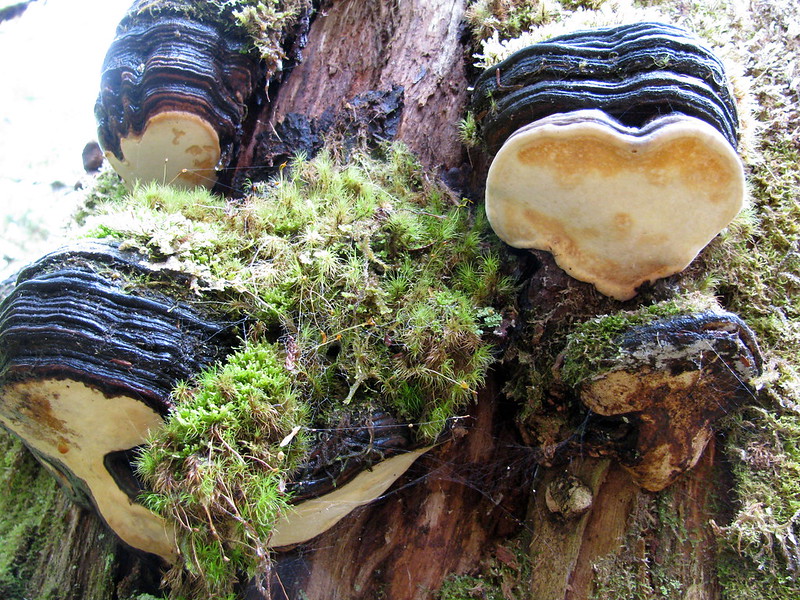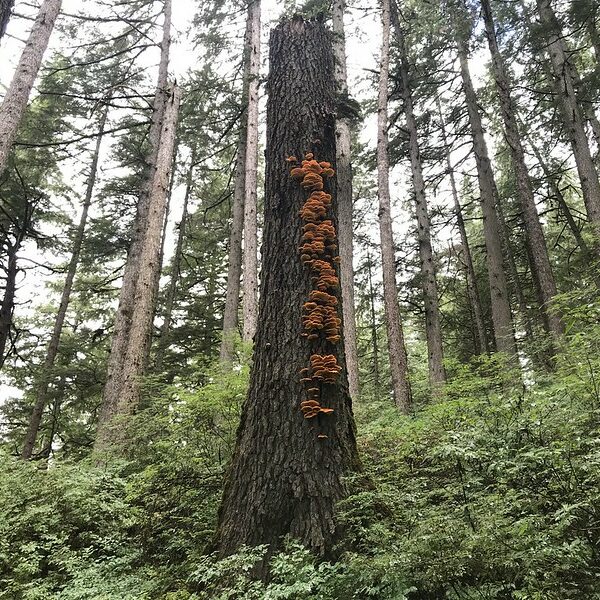Conifer Stem Decays
Caused by several fungi
Host(s) in Alaska: All conifers
Habitat(s): Most decay heartwood, some occupy sapwood & heartwood
Content prepared by Robin Mulvey, Forest Health Protection, robin.mulvey@usda.gov

LINKS TO RESOURCES & PUBLICATIONS
Farr, W. A.; LaBau, V. J.; Larent, T.L. 1976. Estimation of decay in old-growth western hemlock and Sitka spruce in southeast Alaska. Research Paper PNW-204. Portland, OR: U.S. Department of Agriculture, Forest Service. 24 p.
Filip, G.; Chadwick, K.; Zambino, P.; and others. 2011. Seven- to 12-year effects of artificially inoculating living conifers to promote stem decay and subsequent wildlife use in Oregon and Washington forests. Portland, OR: USDA Forest Service, Forest Health Protection.
Hennon, P. E. 1990. Wounding on residual Sitka spruce and western hemlock remaining after thinning on Prince of Wales Island, Alaska. USDA Forest Service, State and Private Forestry, Juneau, AK. Forest Pest Management Report R10 90 2. 9p.
Hennon, P. E. 1995. Are heart rot fungi major factors of disturbance in gap-dynamic forests? Northwest Science. 69: 284-293. Available here.
Hennon, P.E.; McClellan, M. H. 2003. Tree mortality and forest structure in temperate rainforests of southeast Alaska. Canadian Journal of Forest Research 33: 1621-1634.
Hennon, P. E.; Mulvey, R. L. 2014. Managing heart rot in live trees for wildlife habitat in young-growth forests of coastal Alaska. Gen. Tech. Rep. PNW-GTR-890. Portland, OR: U.S. Department of Agriculture, Forest Service, Pacific Northwest Research Station. 23 p. Available here.
Kimmey, J. W. 1956. Cull factors for Sitka spruce, western hemlock, and redcedar in southeast Alaska. USDA Forest Service. Alaska Forest Research Center, Juneau, Alaska. Station Paper No. 6. 31p.
Kimmey, J. W. 1964. Heart Rots of Western Hemlock. USDA Forest Pest Leaflet 90. Available here.
Wright, E.; Isaac, L. A. 1956. Decay following logging injury to western hemlock, Sitka spruce, and true firs. USDA Tech. Bull. No. 1148. 34p.
Stem decays occur on conifer hosts throughout the state, but have been studied in greatest depth in Southeast Alaska. Stem decay incidence changes little over time without active management. In mature forests of Southeast Alaska, conifer stem decays cause enormous wood volume loss. Approximately one-third of the old-growth timber volume in Southeast Alaska is defective, largely due to stem decay. There is very little decay in young-growth stands unless there is prevalent wounding. Stem decays are key disturbance agents in the coastal rainforest, because they predispose large old trees to bole breakage and windthrow. Stem decays create canopy gaps, influence stand structure and succession, perform essential nutrient-cycling functions, increase biodiversity, and enhance wildlife habitat. Trees with stem decay can be hazardous in managed recreation areas. Visit our hazard tree management webpage. Brown rots are the most significant source of cull for Sitka spruce, while white rots are most significant for western hemlock and western redcedar. Western redcedar is the most defective species, followed by western hemlock and Sitka spruce. A variety of different fungi cause stem decay in Alaskan conifers.

Stem decays rot or deteriorate wood, primarily in tree trunks, rather than roots and butts. They can be identified based on the presence and characteristics of conks, mushrooms, or other fungal structures on tree boles, when present. The characteristics of decayed wood and species of host tree can also be helpful for identification. Wildlife holes, cavities, and hollows indicate the presence of stem decay on live trees, even when conks and mushrooms are absent. Heart rot develops primarily in the heartwood (inner wood) of living trees, whereas sap rot develops in the sapwood (outer wood beneath bark) and is usually extensive only in dead trees. Bole wounds and cracks provide entry points for many stem decay fungi, although some decays enter through natural openings like branch stubs.
Brown rots are particularly detrimental to tree strength. They degrade cellulose fibers leaving behind brownish lignin, which dries in brittle cubes. White rots decompose all wood components (cellulose and lignin); wood remains fibrous until very late stages of decay. The color and texture of white rots is dependent upon the causal fungi.
By predisposing large old trees to bole breakage and windthrow, stem decays are key disturbance agents. Individual tree mortality, much of it caused by heart rot fungi, creates small-scale canopy gaps and appears to be the leading form of disturbance in the coastal rainforest (Hennon 1995), where fire and other large-scale disturbances are uncommon. All major tree species in Southeast Alaska have been found killed in this manner. Stem decays influence stand structure and succession, perform essential nutrient cycling functions, increase biodiversity, and enhance wildlife habitat. Heart rot has an obvious and essential role in wood decomposition and has been demonstrated to be a site of nitrogen fixation by other microorganisms. Cavities created by stem decay fungi in standing trees provide crucial habitat for many species (bears, voles, squirrels and birds). Stem decays reduce merchantable timber volume from mature harvest units (especially old-growth) and can be hazardous in managed recreation areas. Many stem decay fungi cause heart rot of living trees, others decay the wood of dead trees, and some grow on dead tissue of both live and dead trees. Most of these decays do not actually interfere with the normal growth and physiological processes of live trees since the vascular system is unaffected. However, some decay pathogens, such as Phellinus hartigii and P. pini may attack the sapwood and cambium of live trees after existing as a heart rot fungus. Many of the fungi that are normally found on dead trees (e.g., Fomitopsis pinicola) can grow on large stem wounds, broken tops and dead tissue of live trees. Root and butt rot fungi can also cause stem decay in the lower bole (e.g., Phaeolus schweinitzii).
Wounds on live trees caused by logging activities are potential sites of infection for decay fungi to cause appreciable timber losses (Wright and Isaac 1956). Generally, larger, deeper wounds and larger diameter breaks in tops result in a faster rate of decay (Hennon 1990). Without logging injury, heart rot in young forests are typically at very low levels until stand age 100 to 150 years. Eventually, heart rot consumes as much or more wood volume annually than is produced by the live trees. There are methods that could be used to promote earlier development of stem decays for wildlife habitat in young-growth stands with non-timber objectives (Filip et al. 2011, Hennon and Mulvey 2014), such as intentional bole wounding and top breakage during stand entries. In some instances, bole breakage can be encouraged to occur in a specific direction (e.g., across steams for coarse woody debris input) by causing wounds to one side of the bole (e.g., the side that faces the stream).
